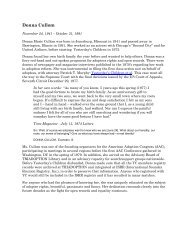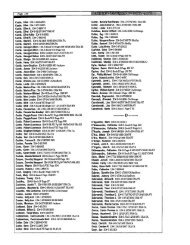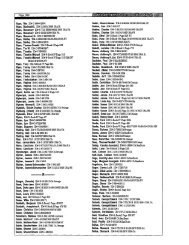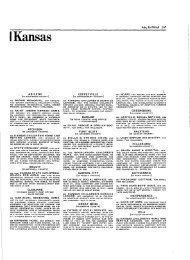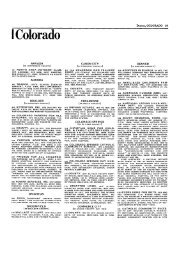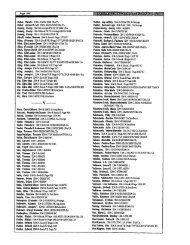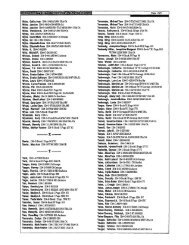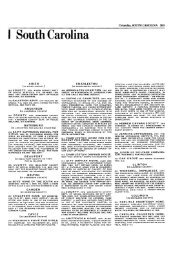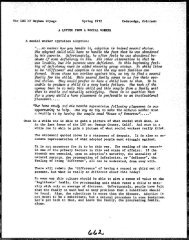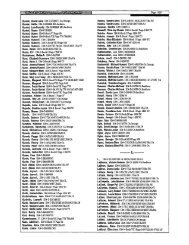Articles Book III - Pg 300-560 (Birthparents) - triadoption
Articles Book III - Pg 300-560 (Birthparents) - triadoption
Articles Book III - Pg 300-560 (Birthparents) - triadoption
Create successful ePaper yourself
Turn your PDF publications into a flip-book with our unique Google optimized e-Paper software.
consideration even thouoh he was an or.<br />
phan. or a foster child. or hadn't adjusted<br />
to adoption, or whatever, a child who<br />
didn't take Iris "come-uppance" lying<br />
down, this type of child was seriously<br />
abused and neglected in terms of having his<br />
rights protected. The state as parent has<br />
always lailed the children taken from their<br />
families. No amount of legal rights will ever<br />
protect the child unless these rights begin<br />
with the statement that no child shall be<br />
over arbitrarily separated lrom his family.<br />
We become interested in this because we<br />
felt that a child has certain basic rights, certaln<br />
basic human rights, and we started our<br />
programs on the premise that the alternative<br />
care that was offered to a child away<br />
from his own family should, as a minimum.<br />
at least be equal to what he would have<br />
gotten in terms of human care had he not<br />
been removed lrom his family. We tried to<br />
go further than just physical care. We tried<br />
to prov~de love, involvement, concern,<br />
commitment, advocacy, all those kinds of<br />
dimensions that should be part of what a<br />
child should be guaranteed as a basic right.<br />
Even though we weren't his parents, we<br />
were sponsored by his guardian or parents<br />
to do a job for the child because of the<br />
problems that he liad. We always addressed<br />
ourselves to the question. 'What<br />
would we do for this child il lie were our<br />
own?' We said, treat the child as though he<br />
were our own, as a means of communicating<br />
that we recognized that the child<br />
with problems shares the same needs that<br />
any child has and that these needs can best<br />
be met within a functional fam~ly model<br />
that approximates the family care, love and<br />
support of the extended lamily in nature.<br />
We liad a number of court cases that we<br />
became involved in because of this. The<br />
llrst one never became a celebrated case<br />
because by the time we got into wardship<br />
court an arrangement had been agreed to.<br />
That was the case ol a girl named Betty<br />
who liad been mode a ward ol a Children's<br />
Aid Society, and whose mother had sub.<br />
sequently married. We found Betty's<br />
mother for her and got them back together<br />
and the mother wished to have her child ro-<br />
turned and the child wished to be returned.<br />
At that time there had been no case of o child<br />
having wardship reversed to the parent.<br />
During the preliminary discussions we were<br />
told that tho difficulty was that it wasn't<br />
legally possible. according to the spokesman<br />
for the Childten's Aid Society, to<br />
reverse a wardship decision. Once a<br />
child had bean declared a child of the state<br />
that was the end of the matter: there was<br />
no legal way you could. at a later time,<br />
declare the parents fit parents and have the<br />
child returned to them. Family failure was<br />
seen as irreversible. We challenged that.<br />
We worked it out with the parents, with the<br />
child, with tho Children's Aid Society and<br />
with the juvenile court judge who was quite<br />
agreeable to reversing the wardship procedure<br />
and Betty was returned to her<br />
mother. I heard from her many times after<br />
that and, as far as I know, she has lived<br />
happily ever after and is still doing so.<br />
somewhere in Eastern Ontario.<br />
The second case we dealt with, again, did<br />
not become a case in law becouse we were<br />
able to resolve it outside the courts. This<br />
was the case of two girls who had been<br />
made wards of the Toronto Children's Aid<br />
Society but who remained under the watchful<br />
eye of their father. He had never accepted<br />
the fact that he had been deemed<br />
incapable of coping with them and he had<br />
continually hassled the Children's Aid<br />
Society. Furthermore, he lied refused to<br />
pay the fee that had beon assigned at the<br />
lime of the werdship hearing as his con.<br />
tribution to the cost of their care. So not<br />
only was lie obnoxious in his dealings with<br />
the Children's Aid Society, he also refused<br />
to moot his financial obligations to them.<br />
We became involved with this man alter he<br />
had tracked down his children to our treatmont<br />
facility in Newmarket. Ontario. We<br />
began to work with the father and the<br />
mother. Tcdda Petri, a Dutch social worker<br />
who *was a member ol our staff at that<br />
time, was extrenioly tactful i~nd sensitive in<br />
her work with families, helping to bring out<br />
the strengths and good qualities that parents<br />
had around their children. She spent a lot<br />
FAMILY INVOLVEMENT





